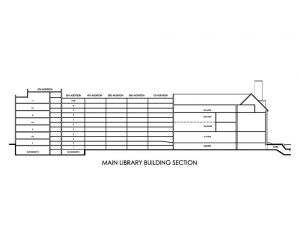Building Project
Many of you will recall the Library’s 2009 Master Plan, a building project that focused on a dramatic transformation of the Main Library and the repurposing of the Undergraduate Library building as a facility devoted to special collections. That plan was impressive and ambitious but, at more than $300m, was also beyond the means of most institutions.
I’m pleased to report that we may have a strategy to make the key concepts in that original master plan viable, and that our re-envisioned strategy for a 2018 Main Library building project has preliminary support from the campus. Over much of the last year, Jeff Schrader has worked with campus planners to develop conceptual drawings and estimates for the work that would be necessary to move forward with this project. Associate Provost for Capital Planning Matthew Tomaszewksi reviewed those plans with Jeff and me, helping to confirm the viability of the plans and getting some early buy-in from campus administration.
I am writing to give you a sense of what the construction will do for the university and the Library. The 2009 Master Plan has two primary components: remaking much of the Main Library as an open and flexible space devoted to engagement with our students and faculty, and devoting the Undergraduate Library building to special collections. By keeping the 6th stack addition (see below), consolidating collections, and demolishing the 1st through 5th stack additions, we will be able to add 100,000 square feet of flexible space where we can foster collaborative activities between and with significant portions of our user community. Of course this will require us to engage vigorously with managing our print collections, a process that is already underway. That space would be the new home to services now located in the Undergraduate Library (e.g., the Media Commons) and would allow us to find important synergies between services that are now split between the two buildings.
At the same time, this project affords us other important opportunities. As mentioned, we will be able to co-locate a broad array of our special collections in the Undergraduate Library building. We are justifiably proud of our Rare Book and Manuscript Library and the University Archives. Giving them a home will not only allow us to consolidate scattered services but should also allow us to create more appropriate facilities for their users. Attention to climate control and storage will undoubtedly help us manage these valuable collections.
Another important opportunity we gain in this effort is the creation of an instructional facility, in collaboration with the Gies College of Business. Our university, led by the College of Engineering, has just launched an effort to build a large, shared instructional facility to the west of the Grainger Engineering Library Information Center. The Gies College of Business is excited about the possibility of creating a similar facility to the south of the stack additions, between the Main Library building and Gregory Street. That facility will help the university advance instructional efforts and create an exciting partnership with the Library.
There are many things that contribute to making this new plan viable. The scope and cost of these plans are much more consistent with the original $55m capital request to the state intended to kick off the construction. The plans are consistent with the campus’s overarching master plan. There is much in this that resonates with a variety of proposals put forward by LAS and other colleges, especially in the humanities and the social and behavioral sciences. I am hopeful that the effort will become a campus priority and that supporters of the Library will be enthusiastic.
Much needs to be done to realize this vision, and we are only in the earliest stage. As we move through stages that include approval from the Chancellor’s Capital Review Committee, to securing architectural plans, to fundraising, we will need to plan and act to make this vision real. I am excited by the possibility of creating a facility that, much like Beckman does for the sciences, will catalyze activities for disciplines that benefit from access to the record of human knowledge, from collaboration across disciplinary boundaries, and from engagement with library faculty and staff. Expect to hear and read more about our exciting plans as we move forward, beginning with the to-be-scheduled Library Update in the spring.
John Wilkin
The Juanita J. and Robert E. Simpson Dean of Libraries and University Librarian


